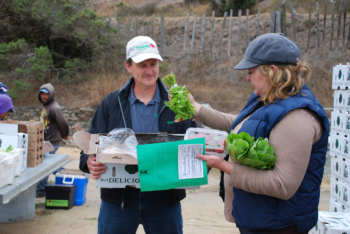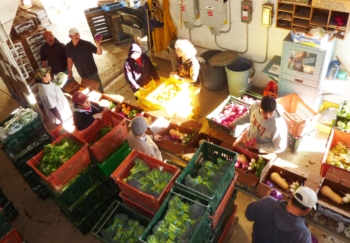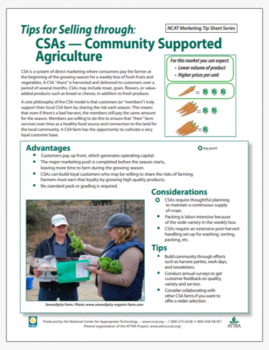Tips for Selling through CSAs — Community Supported Agriculture
NCAT Marketing Tip Sheet Series
By Marisa Alcorta, Rex Dufour, and Tammy Hinman, NCAT Agriculture Specialists

Photo: Serendipity Farm
CSA is a system of direct marketing where consumers pay the farmer at the beginning of the growing season for a weekly box of fresh fruits and vegetables. A CSA “share” is harvested and delivered to customers over a period of several months. CSAs may include meat, grain, flowers, or valueadded products such as bread or cheese, in addition to fresh produce. A core philosophy of the CSA model is that customers (or “members”) truly support their local CSA farm by sharing the risk each season. This means that even if there’s a bad harvest, the members still pay the same amount for the season. Members are willing to do this to ensure that “their” farm survives over time as a healthy food source and connection to the land for the local community. A CSA farm has the opportunity to cultivate a very
loyal customer base.
For this market you can expect:
- Lower volume of product
- Higher price per unit
Advantages
- Customers pay up front, which generates operating capital.
- The major marketing push is completed before the season starts, leaving more time to farm during the growing season.
- CSAs can build loyal customers who may be willing to share the risks of farming.
Farmers must earn that loyalty by growing high-quality products. - No standard pack or grading is required.
Considerations
CSAs require thoughtful planning to maintain a continuous supply of crops.
- Packing is labor-intensive because of the wide variety in the weekly box.
- CSAs require an extensive post-harvest handling set-up for washing, sorting, packing, etc.
Tips
- Build community through efforts such as harvest parties, work days, and newsletters.
- Conduct annual surveys to get customer feedback on quality, variety and service.
- Consider collaborating with other CSA farms if you want to offer a wider selection.
Key Questions to Ask Yourself
Timing and planning are critical in a CSA. How will I ensure consistent weekly harvests of a variety of vegetables and fruits for my CSA customers? See ATTRA’s Scheduling Vegetable Plantings for a Continuous Harvest.
- How many other CSA farms are in my area? Do they have waiting lists—unmet demand that I could tap into?
- Will I enjoy the social aspects of running a CSA, such as hosting festive gatherings or work days for members, writing newsletters to include in weekly boxes, and generally creating opportunities for people to get to know the farm?

Packing CSA boxes, Full Belly Farm, Guinda, California. Photo: Rex Dufour, NCAT
Further Resources
ATTRA Publications
- Market Gardening: A Start-Up Guide
- Scheduling Vegetable Plantings for Continuous Harvest
- Season Extension Techniques for Market Gardeners
- Community Supported Agriculture
Books and Guides
- Sharing the Harvest: A Citizen’s Guide to Community Supported Agriculture. By Elizabeth Henderson with Robin Van En. Chelsea Green Publishing, 2nd edition, 2007.
This 300-page book provides valuable insight into making CSA a viable economic model as well as an excellent arrangement for farmers and food lovers alike. It provides information on starting a CSA and how to strengthen existing CSA operations. - Community Supported Agriculture. By Matt Ernst and Tim Woods. University of Kentucky College of Agriculture, New Crops Opportunity Center.
CSA Software
- Farmigo is a computer software subscription service that provides recordkeeping and membership management. It costs 2% of gross sales from the CSA or farm.
- CSA Toolbox is an online “toolbox” that offers programs to communicate with your customers, do your paperwork, handle your billing, and take payments.
- CSAware is a customizable, user-friendly Community Supported Agriculture software from LocalHarvest.com designed for CSAs with lots of moving parts. The cost is 2% of sales.
Tips for Selling Through CSAs—Community Supported Agriculture
By Marisa Alcorta, Rex Dufour, and Tammy Hinman, NCAT Agriculture Specialists
Published December 2012
© NCAT
IP422
This publication is produced by the National Center for Appropriate Technology through the ATTRA Sustainable Agriculture program, under a cooperative agreement with USDA Rural Development. This publication was also made possible in part by funding from USDA/NIFA/OASDFR. ATTRA.NCAT.ORG.
Related Publications
- Tips for Selling at Farmers Markets
- Tips for Selling to Aggregators/Grower Marketing Coops
- Tips for Selling to Institutional Markets
- Tips for Selling to Wholesale Buyers at Terminal Markets
- Tips for Selling to Produce Distributors
- Tips for Selling to Produce Packing Houses
- Tips for Selling with Agritourism and “Pick-Your-Own”


